Although these patterns appear in the markets almost daily, successfully identifying and trading them is no easy task, writes the staff at Investopedia.com.
No chart pattern is more common in trading than the double bottom or double top. In fact, this pattern appears so often that it alone may serve as proof positive that price action is not as wildly random as many academics claim. Price charts simply express trader sentiment and double tops and double bottoms represent a retesting of temporary extremes. If prices were truly random, why do they pause so frequently at just those points? To traders, the answer is that many participants are making their stand at those clearly demarcated levels.
If these levels undergo and repel attacks, they instill even more confidence in the traders who've defended the barrier and, as such, are likely to generate strong profitable countermoves. Here we look at the difficult task of spotting the important double bottom and double tops, and we demonstrate how Bollinger Bands can help you set appropriate stops when you're trading these patterns.
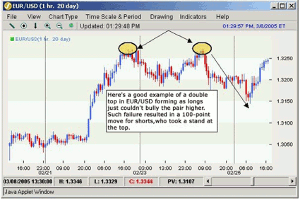
Chart Created by Intellichart from FXtrek.com
Click to Enlarge

Chart Created by Intellichart from FXtrek.com
Click to Enlarge
React or Anticipate?
One great criticism of technical pattern trading is that setups always look obvious in hindsight but that executing in real time is actually very difficult. Double tops and double bottoms are no exception. Although these patterns appear almost daily, successfully identifying and trading the patterns is no easy task.
There are two approaches to this problem and both have their merits and drawbacks. In short, traders can either anticipate these formations or wait for confirmation and react to them. Which approach you chose is more a function of your personality than relative merit. Those who have a fader mentality—who love to fight the tape, sell into strength, and buy weakness—will try to anticipate the pattern by stepping in front of the price move.
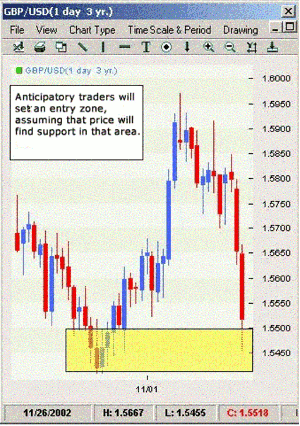
Chart Created by Intellichart from FXtrek.com
Click to Enlarge
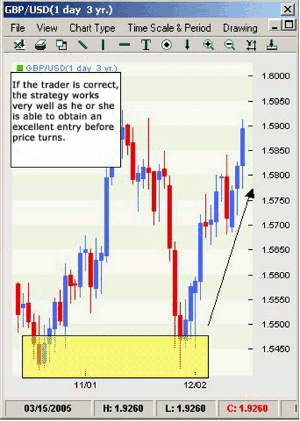
Chart Created by Intellichart from FXtrek.com
Click to Enlarge
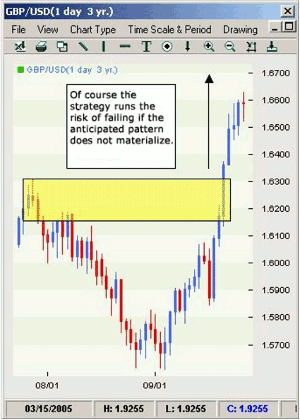
Chart Created by Intellichart from FXtrek.com
Click to Enlarge
Reactive traders, who want to see confirmation of the pattern before entering, have the advantage of knowing that the pattern exists, but there's a tradeoff: they must pay worse prices and suffer greater losses should the pattern fail.
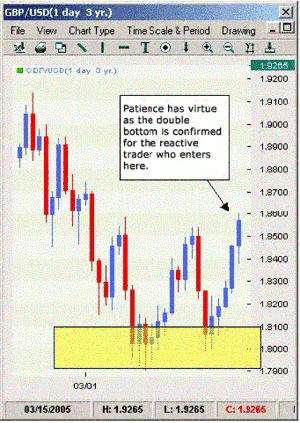
Chart Created by Intellichart from FXtrek.com
Click to Enlarge
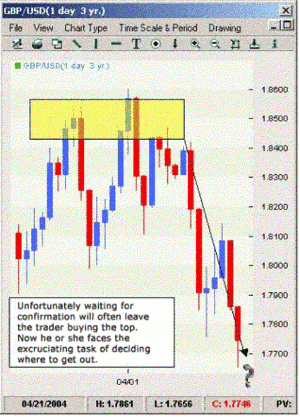
Chart Created by Intellichart from FXtrek.com
Click to Enlarge
What's Obvious Is Not Often Right
Most traders are inclined to place a stop right at the bottom of a double bottom or top of the double top. The conventional wisdom says that once the pattern is broken, the trader should get out. But conventional wisdom is often wrong.
Leaving the trade early may seem prudent and logical, but markets are rarely that straightforward. Many retail traders play double tops/bottoms, and, knowing this, dealers, and institutional traders love to exploit the retail traders' behavior of exiting early, forcing the weak hands out of the trade before price changes direction. The net effect is a series of frustrating stops out of positions that often would have turned out to be successful trades.
NEXT PAGE: What Are Stops For?
|pagebreak|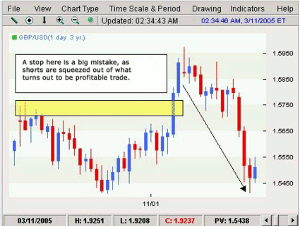
Chart Created by Intellichart from FXtrek.com
Click to Enlarge
What Are Stops For?
Most traders make the mistake of using stops for risk control. But risk control in trading should be achieved through proper position size, not stops. The general rule of thumb is never to risk more than 2% of capital per trade. For smaller traders, that can sometimes mean ridiculously small trades.
Fortunately in FX where many dealers allow flexible lot sizes, down to one unit per lot—the 2% rule of thumb is easily possible. Nevertheless, many traders insist on using tight stops on highly leveraged positions. In fact, it is quite common for a trader to generate 10 consecutive losing trades under such tight stop methods. So, we could say that in FX, instead of controlling risk, ineffective stops might even increase it. Their function, then, is to determine the highest probability for a point of failure. An effective stop poses little doubt to the trader over whether he or she is wrong.
Implementing the True Function of Stops
A technique using Bollinger Bands can help traders set those proper stops. Because Bollinger Bands incorporate volatility by using standard deviations in their calculations, they can accurately project price levels at which traders should abandon their trades.
The method for using Bollinger-Bands stops for double tops and double bottoms is quite simple:
- Isolate the point of the first top or bottom, and overlay Bollinger Bands with four standard-deviation parameters.
- Draw a line from the first top or bottom to the Bollinger Band. The point of intersection becomes your stop.
At first glance four standard deviations may seem like an extreme choice. After all, two standard deviations cover 95% of possible scenarios in a normal distribution of a dataset. However, all those who have traded financial markets know that price action is anything but normal—if it were, the type of crashes that happen in financial markets every five or 10 years would occur only once every 6,000 years. Classic statistical assumptions are not very useful for traders. Therefore setting a wider standard-deviation parameter is a must.
The four standard deviations cover more than 99% of all probabilities and therefore seem to offer a reasonable cut-off point. More importantly they work well in actual testing, providing stops that are not too tight, yet not so wide as to become prohibitively costly. Note how well they work on the following GBP/USD example.
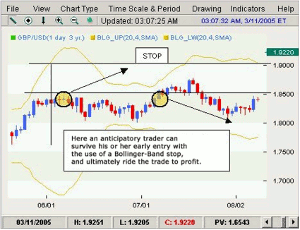
Chart Created by Intellichart from FXtrek.com
Click to Enlarge
More importantly, take a look at the next example. A true sign of a proper stop is a capacity to protect the trader from runaway losses. In the following chart, the trade is clearly wrong but is stopped out well before the one-way move causes major damage to the trader's account.
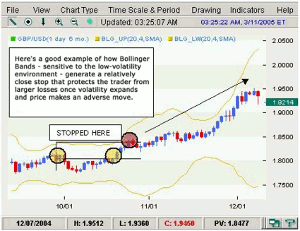
Chart Created by Intellichart from FXtrek.com
Click to Enlarge
The Bottom Line
The genius of Bollinger Bands is their adaptability. By constantly incorporating volatility, they adjust quickly to the rhythm of the market. Using them to set proper stops when trading double bottoms and double tops—the most frequent price patterns in FX—makes those common trades much more effective.
By the Staff of Investopedia.com


















